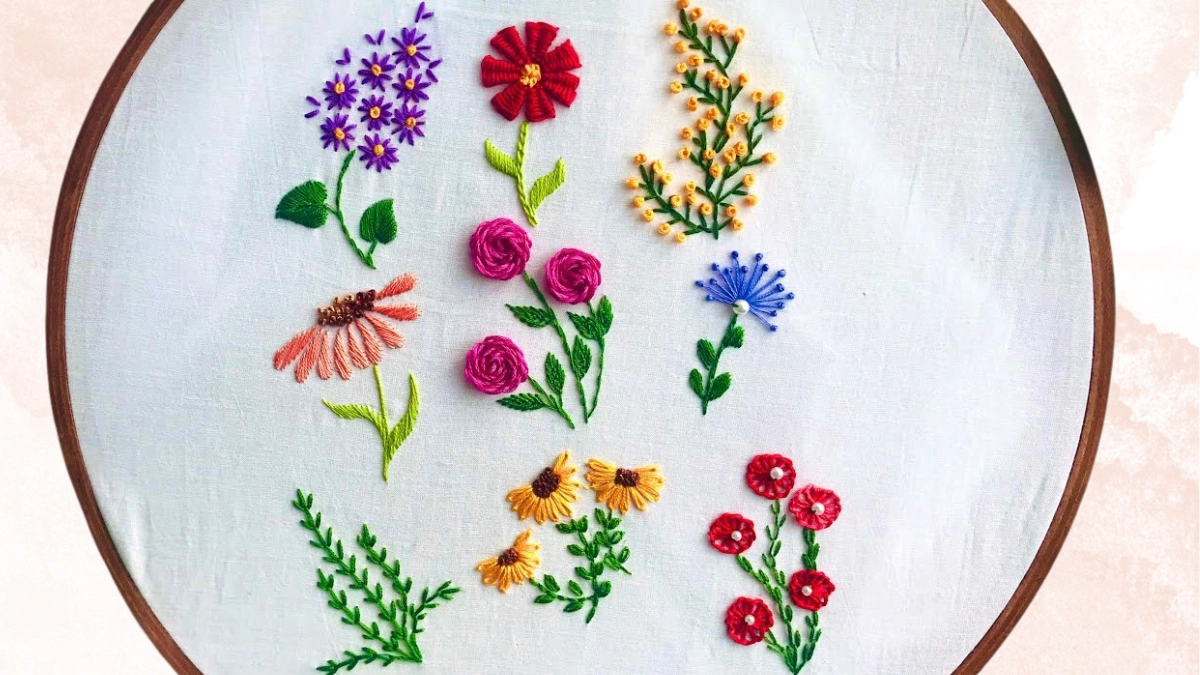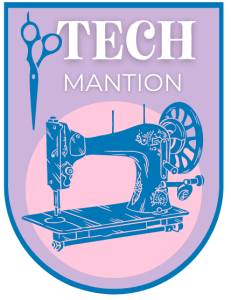Tired of scrolling through fashion feeds, envying the custom, designer jeans with those beautifully embroidered flowers? It’s time to stop dreaming and start stitching!
Learning how to embroider flowers on jeans can rescue any pair from the depths of your closet and turn them into a statement piece.
This article is your step-by-step guide to mastering the art of floral embroidery on denim. With easy-to-follow instructions, you’ll discover how to add vibrant, eye-catching designs to your jeans, giving them a new lease on life.
Finally, you will have a floral embroidered denim jean. This is a DIY hand embroidery guide. Prepare to elevate your fashion game with needle, thread, and a dash of imagination!
Table of Contents
- 1 Embroidery on Jeans
- 2 Materials and Tools
- 3 Quick Steps to embroider designs on jeans
- 4 Where should I place the pattern on my jeans?
- 5 5 Tips to Design Your Floral Pattern
- 6 Preparing the Jeans for Embroidery
- 7 Transferring the Design to Jeans
- 8 Embroidering the Flowers
- 9 Finishing Touches
- 10 Care and Maintenance
- 11 FAQs on How to Embroider Flowers on Jeans
- 12 Final Thoughts
Embroidery on Jeans
Embroidery on jeans adds a personal touch to any wardrobe, transforming simple garments into unique pieces. This section will guide one through the basics, stitches, and techniques specific to denim embroidery.
Understanding Embroidery Basics
Embroidery involves decorating fabric with thread or yarn and using a needle to craft patterns and designs. Materials needed typically include an embroidery hoop, thread, needles, and the fabric of choice—in this case, denim jeans.
Exploring Embroidery Stitches
Various stitches serve different purposes in embroidery. Basic stitches include the running stitch, backstitch, and satin stitch. For beginners, it’s crucial to learn a few stitches and practice consistently to gain proficiency before attempting more complex designs.
Can you embroider directly onto denim?
One can certainly embroider directly onto denim. Due to its sturdy nature, denim makes an excellent fabric for embroidery, though it may require a stronger needle and a hoop to keep the fabric taut while working.
Is it hard to embroider on denim?
Embroidery on denim can be more challenging than on lighter fabrics. The thickness of denim means extra effort to push the needle through; however, using a sharp, thick needle and thimble can make the process smoother.
What is the best stitch for denim?
The best stitch for denim would likely be the backstitch for its durability and strength. Denim, being a heavier fabric, benefits from sturdy stitches that can withstand regular wear and tear.
Materials and Tools

Embroidering flowers on denim requires specific materials and tools engineered to handle the fabric’s thickness. These choices affect the final embroidery’s quality and ease of completion.
Choosing an Embroidery Needle for Denim
For denim, a strong, thick needle is necessary. One should select a chenille needle, typically ranging in sizes from 18 to 22, as these sizes are optimal for piercing the dense material. A size 18 needle can be used for heavier threads, while a size 22 is better suited for finer threads.
Choose Suitable Embroidery Thread for Denim
When it comes to threads, durability, and color fastness are as important as the aesthetic. Embroidery floss made from 100% cotton is preferred, ensuring a smooth finish. For a bold, vibrant outcome, six-stranded floss works best, allowing for adjustments in thickness by separating the strands.
Quick Steps to embroider designs on jeans
Materials Needed:
- A pair of jeans
- Flower pattern or design
- Embroidery hoop
- Embroidery needles
- Embroidery floss in various colors
- Scissors
- Tailor’s chalk, fabric marker, or water-soluble pen
- Pins or masking tape
- Stabilizer (optional, for thinner denim)
- Tracing paper (optional)
One begins by selecting a suitable area on the jeans for the floral embroidery. It’s essential to have enough flattish space for the design to lie properly. They then sketch the floral pattern onto paper, which helps in visualizing the final look. Using a variety of flower types and sizes adds visual interest to the embroidery.
Next, the transfer of the design onto the jeans is crucial. They might use transfer paper or a fabric marking pen that’s safe for denim. The lines of the design must be clear but not permanent.
When the design is transferred, the embroiderer should choose thread colors. They often select thread colors that contrast well with the denim for the flowers to stand out. For a subtle effect, they might choose colors closer to the denim’s hue.
Finally, they secure the jeans in an embroidery hoop. The use of an embroidery hoop helps to maintain fabric tension, which in turn provides more even stitches. They take care not to stretch the denim too tightly, to avoid distortion once the hoop is removed.
Now we know the steps needs to follow. Let’s go deep in each step with more insights.
Where should I place the pattern on my jeans?
One must identify a flat surface on the jeans where the embroidery will be most visible and impact. Common areas include the thigh, calf, hemlines, or back pockets. It’s essential to choose a spot that offers enough space for the embroidery design without interfering with seams or other structural elements.
5 Tips to Design Your Floral Pattern

Creating a compelling floral pattern on jeans involves intentional design choices. The artist must consider placement, size, and color to ensure the embroidery enhances the garment aesthetically.
1. Start Simple: Begin with basic flower shapes like daisies or simple roses to gain confidence. Use clear, uncomplicated lines that are easy to stitch.
2. Consider Placement: Position your design where it will stand out, such as on pockets or along the hem. Avoid areas with thick seams to make the embroidery process smoother.
3. Play with Size: Mix different sizes of the same flower to create depth and interest. Larger blooms can be focal points, while smaller ones can fill gaps or add detail.
4. Color Coordination: Choose thread colors that contrast well with your jeans for the flowers to pop, but also consider the overall color scheme to ensure harmony in your design.
5. Balance Your Design: Distribute flowers evenly or create a pattern that flows naturally with the shape of the jeans. Asymmetry can be visually appealing, but balance is key to a cohesive look.
Preparing the Jeans for Embroidery
Proper preparation of jeans is crucial for a successful embroidery project. The process ensures the fabric is stable and improves the quality of the finished design.
Securing the Fabric
Having chosen the area for embroidery, one must stabilize the fabric to prevent puckering. This typically involves using an embroidery hoop:
- Resize the hoop. Ensure the hoop is slightly larger than the embroidery design.
- Position the fabric. Stretch the selected jeans area over the inner hoop.
- Secure the hoop. Place the outer hoop over the fabric and inner hoop and tighten to hold the fabric taut.
Please note that over-stretching could distort the fabric and the final embroidery.
Transferring the Design to Jeans
Before beginning the embroidery process, one must transfer the design onto the jeans to serve as a guide. The design can be as simple or complex as desired, but this step is crucial for achieving the desired outcome.
Steps:
- Prepare the Jeans: Ensure the jeans are clean and ironed. For best results, they should be without wrinkles to achieve a smooth surface for the design transfer.
- Secure the Design:
- If using tracing paper, place the tracing paper over the printed or sketched design, then trace it using a pencil or pen.
- Pin the traced design or place the original sketch on the area of the jeans where the embroidery will be applied. Use pins or masking tape to hold it in place.
- Trace the Design: Employ tailor’s chalk, a fabric marker, or a water-soluble pen to trace the design onto the jeans.
- If using tracing paper, one would need to press firmly to ensure the transfer.
- Without tracing paper, trace over the lines of the design carefully.
- Remove the Paper: Once the design is transferred, gently remove the tracing paper or pins without smudging the lines.
- Hooping:
- Place the embroidery hoop around the transferred design, making sure the fabric is taut.
- The hoop should be tightened securely, maintaining a stable surface to work on.
Read our full article on transfer pattern on to fabric and explore appropriate methods.
Having the design transferred neatly to the jeans provides a framework for effective embroidery and ensures that the result is aligned with the embroiderer’s vision.
Embroidering the Flowers
Embroidering flowers on jeans can transform a simple pair of denim into a unique piece of art. It requires selecting the right colors and stitches and skillfully applying various embroidery techniques.
Starting Your Embroidery
Before one begins, they must ensure the jeans are clean and ironed. Choosing an area to embroider, like a pocket or thigh, is the first step. They should secure the fabric in an embroidery hoop to provide a taut surface for even stitching. A water-soluble marker can be useful for sketching the design directly onto the jeans.
Choosing Colors and Stitches
Selecting color combinations that complement the denim is crucial for a visually appealing design. Embroiderers often choose vibrant, contrasting embroidery floss to make the design stand out. As for stitches, a variety includes:
- French knot: Ideal for small flower centers.
- Satin stitch: Creates a smooth, filled surface perfect for petals.
- Split stitch: Gives texture and definition to flower outlines.
Applying Embroidery Techniques
Skilled application of embroidery techniques brings the design to life. Key strategies include:
- Stitching from the center outward to maintain the design’s proportions.
- Use varying stitch lengths for a more natural look.
- Incorporating different techniques like French knots on denim jeans for intricate details.
Finishing Touches
After meticulously stitching your floral design, the final steps are crucial for ensuring the longevity and neatness of your embroidery on jeans.
Knotting and Trimming Thread
Once the last stitch is in place, one must securely knot the thread to prevent unraveling. A simple method is to pass the needle through the loop of the last stitch twice before pulling tight to form a knot.
Close trimming of the excess thread is essential; it should be done as close to the fabric as possible without risking damage to the stitch work.
Sealing the Embroidery
Sealing the embroidery adds an extra layer of protection, especially for frequently washed items like jeans. An embroidery sealant or a light application of clear fabric glue can be applied to the backside of the stitches.
This secures loose ends and ensures the design remains intact through wear and cleaning. It is imperative to allow adequate drying time as recommended by the sealant’s manufacturer.
Our in detailed article on embroidering flowers on converse shoes describe how add extra beauty to your sneakers
Care and Maintenance
Proper care and maintenance ensure the longevity and beauty of embroidered jeans. This section provides specific guidelines for washing and ongoing care.
Washing Embroidered Jeans
- Cold Water: Always use cold water to wash embroidered jeans, as it helps prevent the colors from fading.
- Gentle Cycle: Use a gentle cycle or hand wash to protect the embroidery from damage.
- Inside Out: Turn the jeans inside out before washing to reduce abrasion on the embroidery.
- Mild Detergent: A mild detergent is less harsh on the fabric and embroidery threads.
Long-Term Care Tips
- Ironing: If ironing is necessary, do so on the reverse side of the embroidery or place a protective cloth over the design to guard against heat damage.
- Storage: Store embroidered jeans away from direct sunlight and in a dry environment to prevent fading and mildew.
- Repairs: Attend to any loose threads or damaged areas promptly to prevent further unraveling or damage.
FAQs on How to Embroider Flowers on Jeans
Do you need backing to embroider on denim?
Yes, using a stabilizer as backing when embroidering on denim is recommended. It helps prevent puckering and maintains the quality of the embroidery, especially on lighter-weight denim.
Which stitch is best for making flowers?
The satin stitch is ideal for creating smooth, filled-in petals, while the French knot is perfect for adding dimension to the center of flowers in embroidery.
Final Thoughts
In conclusion, learning how to embroider flowers on jeans is a delightful way to personalize your denim and showcase your creativity. With the right tools, a bit of patience, and your blossoming embroidery skills, you can transform any ordinary pair of jeans into a unique fashion statement.
So grab your needle and thread, and let your imagination bloom into vibrant, textile art that expresses your style.








